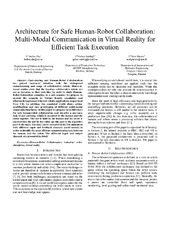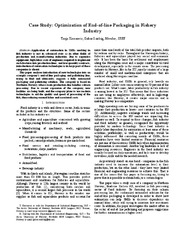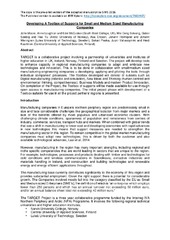Blar i forfatter "Sziebig, Gabor"
-
Architecture for Safe Human-Robot Collaboration: Multi-Modal Communication in Virtual Reality for Efficient Task Execution
Shu, Beibei; Sziebig, Gabor; Pieters, Roel (Peer reviewed; Chapter; Bokkapittel, 2019-08-01)Task-sharing and Human-Robot Collaboration has gained increased attention with the widespread commissioning and usage of collaborative robots. However, recent studies show that the fenceless collaborative robots are not as harmless as they look like. In order to study Human-Robot Interaction scenarios, in a safe manner, we propose to execute the scenario in Virtual Reality simulation and afterwards ... -
Case study: Optimization of End-of-line Packaging in Fishery Industry
Sziebig, Gabor; Kerezovic, Tanja (Peer reviewed; Bokkapittel; Chapter, 2016)Application of automation in SMEs working in fish industry is not in advanced state as in other fields of production and manufacturing industries. Due to expensive equipment, high labor costs of engineers required to implement such features into production lines, and low-quantity contracts, introduction of automation technologies is in large part of these companies is absent. This paper analyses ... -
Collaboration with High-Payload Industrial Robots: Simulation for Safety
Shu, Beibei; Sziebig, Gabor (Journal article; Tidsskriftartikkel; Peer reviewed, 2018-12-15)<p>When operators and industrial robots are sharing the same task, there are multiple factors, which effect if a system is safe for the human operator or not. In general this is solved by introducing Collaborative Robot for cooperation, but what happens when we would extend our already existing production facilities with newer comfort features?</p> <p>In this paper we propose to include industrial ... -
Developing a Toolbox of supports for small and medium sized manufacturing companies
Moore, John; Loughran, Anne; McCusker, Edel; Solvang, Wei Deng; Sziebig, Gabor; Yu, Hao; Ericson, Åsa; Holmqvist, Johann; Wenngren, Johann; Pieskä, Sakari; Vahasoyrinki, Juoni; Kaartinen, Heidi (Konferansebidrag; Conference object, 2016)TARGET is a collaborative project involving a partnership of universities and institutes of higher education in UK, Ireland, Norway, Finland and Sweden. The project will develop tools to enhance capacity in regional manufacturing companies to adapt and embrace new technologies and innovation. This is to be done in collaboration with small/medium sized manufacturing engineering companies - developing, ... -
Future Role of Application of New Technologies in Small-and Medium Scale Manufacturing Systems - Regarding Intelligent and Advanced Manufacturing Systems in Northern Peripheral Area
Somlò, Kinga; Sziebig, Gabor (Conference object; Konferansebidrag, 2017-08-08)Nowadays the concept of Industry 4.0. and the relating intelligent manufacturing system are getting more and more current and well-known. In the past years the outstanding development of different areas such as information technology computer science, machining, robotics and so on, made possible a comprehensive transformation of the manufacturing systems. Present paper aims to give a general overview ... -
Human-Robot Collaboration: Task Sharing Through Virtual Reality
Shu, Beibei; Sziebig, Gabor; Pieskä, Sakari (Peer reviewed; Book; Chapter, 2018-12-31)Collaborative Robots provide many possibilities, when it comes to Human-Robot Collaboration. Until now, these approaches are usually custom made, sensor-integrated solutions, where the robot's safety controller ensures the safety of the human worker. These solutions are according to today's rules and standards. We propose to extend these solutions with including Virtual Realty as a sensor and to ... -
Introduction of cyber-physical system in robotized press-brake line for metal industry
Shu, Beibei; Sziebig, Gabor; Solvang, Bjørn (Journal article; Tidsskriftartikkel; Peer reviewed, 2018-02-11)Bin picking is a typical work, which is easy to automate up to a given complexity of the work-piece dimensions. In case of casted work-pieces, the dimensions are most of the time not accurate enough for an industrial robot to be able to pick it up without additional sensors/intelligence. In this paper we introduce a cyber-physical system, where all sensors, actuators, machines and industrial robot ... -
A Literature Review on Technologies in Future Small-scale Intelligent Manufacturing Systems
Kerezovic, Tanja; Sziebig, Gabor (Peer reviewed; Chapter; Bokkapittel, 2018-02-05)Emergence of global markets forces businesses to become more flexible and adaptive to constantly changing demands and environments. In order to do so, enterprises turn towards application of newest technologies in manufacturing in order to make them intelligent. Since Small and Medium Enterprises play the central role in the domain of European manufacturing, the question arises – based on their ... -
Overview of modern teaching equipment that supports distant learning
Horvath, Csongor Mark; Thomessen, Trygve; Sziebig, Gabor (Journal article; Peer reviewed, 2018)Laboratory is a key element of engineering and applied sciences educational systems. With the development of Internet and connecting IT technologies, the appearance of remote laboratories was inevitable. Virtual laboratories are also available; they place the experiment in a simulated environment. However, this writing focuses on remote experiments not virtual ones. From the students’ point ... -
Remote Operation and Assistance in Human Robot Interactions with Vibrotactile Feedback
Sziebig, Gabor; Korondi, Peter (Conference object; Konferansebidrag, 2017-08-08)This paper investigates intuitiveness in human robot interactions with focus on remote operation and assistance. The increasing number of robot applications in small volume production requires new techniques to ease the use of these sophisticated systems. A vibrotactile device was used for experiments. Vibration patterns are developed to represent a cognitive information channel for the remote ... -
Welding Certification for Autonomous Robotized Welding
Sziebig, Gabor; Maske, Thomas (Chapter; Bokkapittel, 2016-10-23)The increased production of more and more complex products challenges the accuracy of manual welding, and increase the time it takes to program automatic welding systems. The main objective for the article is to explore if current regulations and standards are able to accommodate the shift from automatic welding to autonomous welding systems. To do this, the most current and applicable standards ...


 English
English norsk
norsk









